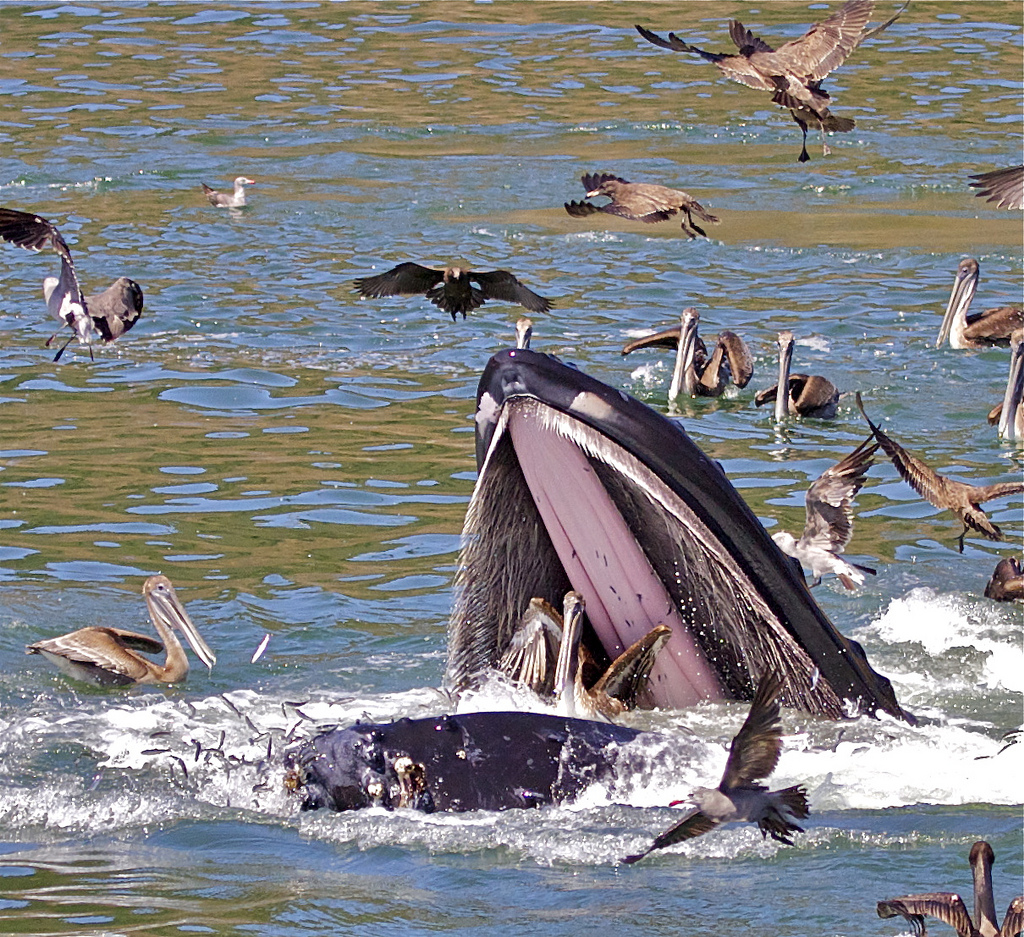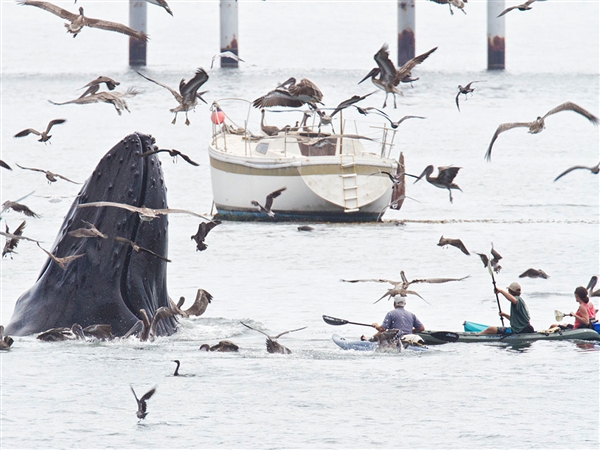Onlookers in Avila Bay’s Port San Luis Harbor were dazzled recently by humpback whales “lunge feeding” on a bait ball near the pier. At least two humpbacks, several pods of sea lions, and hundreds of sea birds delighted spectators and gave photographers the photo op of a lifetime during the event which began on Monday, August 20 and continued the next day.
Evidently, strong northwest winds have caused an upwelling of cold, nutrient-rich waters from the ocean bottom that has fueled blooms of phytoplankton that have led to an explosion of krill, and that, in turn, led to vast numbers of sardines congregating and forming a huge bait ball near the Avila pier. Humpback whales are filter feeders which suck in sea water to capture thousands of fish and krill in a single gulp. Their most inventive technique is known as “bubble net feeding,” in which “a group of whales swims in a shrinking circle blowing bubbles below a school of prey. The shrinking ring of bubbles encircles the school and confines it in an ever-smaller cylinder. This ring can begin at up to 30 metres (98 ft) in diameter and involve the cooperation of a dozen animals. Using a crittercam attached to a whale’s back, some whales were found to blow the bubbles, some dive deeper to drive fish toward the surface, and others herd prey into the net by vocalizing. The whales then suddenly swim upward through the ‘net,’ mouths agape, swallowing thousands of fish in one gulp (lunge feeding). Plated grooves in the whale’s mouth allow the creature to easily drain all the water initially taken in” (Wikipedia: Humpback whale).
“The humpback whale (Megaptera novaeangliae) is a species of baleen whale. One of the larger rorqual species, adults range in length from 12–16 metres (39–52 ft) and weigh approximately 36,000 kilograms (79,000 lb). The humpback has a distinctive body shape, with unusually long pectoral fins and a knobbly head. It is an acrobatic animal, often breaching and slapping the water. Males produce a complex song, which lasts for 10 to 20 minutes and is repeated for hours at a time. The purpose of the song is not yet clear, although it appears to have a role in mating.
Found in oceans and seas around the world, humpback whales typically migrate up to 25,000 kilometres (16,000 mi) each year. Humpbacks feed only in summer, in polar waters, and migrate to tropical or subtropical waters to breed and give birth in the winter. During the winter, humpbacks fast and live off their fat reserves. The species’ diet consists mostly of krill and small fish. Humpbacks have a diverse repertoire of feeding methods, including the bubble net feeding technique.
Once hunted to the brink of extinction, the humpback has made a dramatic comeback in the North Pacific. A 2008 study estimated the humpback population, which hit a low of 1,500 whales before hunting was banned worldwide, has made a comeback to a population of between 18,000 and 20,000. Humpback whales are generally curious about objects in their environments. Some individuals, referred to as “friendlies”, approach whale-watching boats closely, often staying under or near the boat for many minutes. Because humpbacks are often easily approachable, curious, easily identifiable as individuals, and display many behaviors, they have become the mainstay of whale-watching tourism in many locations around the world” (Ibid.).
Editor’s note: Many thanks to Geography staffer Bernadette Weinberg for bringing this material to our attention. Many more photos of this spectacular event can be seen at http://www.flickr.com/photos/teddyllovet/7828673264/, video clips are available at and http://mashable.com/2012/08/20/incredible-humpback-whale-photos/#826495-Bird-frenzy.





